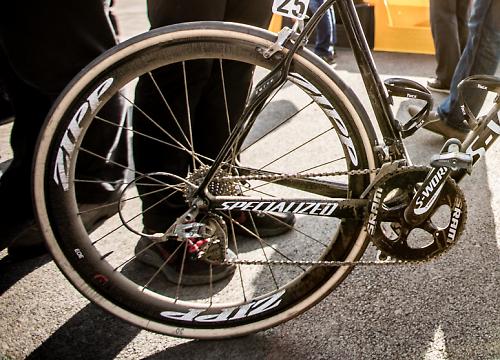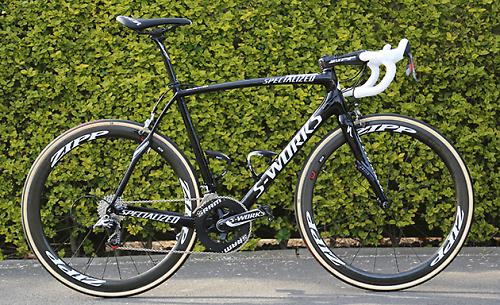- News
- Reviews
- Bikes
- Components
- Bar tape & grips
- Bottom brackets
- Brake & gear cables
- Brake & STI levers
- Brake pads & spares
- Brakes
- Cassettes & freewheels
- Chains
- Chainsets & chainrings
- Derailleurs - front
- Derailleurs - rear
- Forks
- Gear levers & shifters
- Groupsets
- Handlebars & extensions
- Headsets
- Hubs
- Inner tubes
- Pedals
- Quick releases & skewers
- Saddles
- Seatposts
- Stems
- Wheels
- Tyres
- Tubeless valves
- Accessories
- Accessories - misc
- Computer mounts
- Bags
- Bar ends
- Bike bags & cases
- Bottle cages
- Bottles
- Cameras
- Car racks
- Child seats
- Computers
- Glasses
- GPS units
- Helmets
- Lights - front
- Lights - rear
- Lights - sets
- Locks
- Mirrors
- Mudguards
- Racks
- Pumps & CO2 inflators
- Puncture kits
- Reflectives
- Smart watches
- Stands and racks
- Trailers
- Clothing
- Health, fitness and nutrition
- Tools and workshop
- Miscellaneous
- Buyers Guides
- Features
- Forum
- Recommends
- Podcast
TECH NEWS
WorldTour bike: Niki Terpstra’s Specialized Roubaix SL4
Yesterday we brought you news of Niki Terpstra’s Paris-Roubaix winning ride that he uploaded to Strava, now let’s take a close look at his Omega Pharma – Quick-Step Pro Cycling team bike. Like the rest of the team, Tom Boonen included, he rode the Specialized Roubaix SL4.
The S-Works Roubaix bike that Niki rides is essentially the same as the Roubaix SL4 that you can buy in the shops (and the disc version Mat rode at Eurobike last year). However, like most of the other bikes prepared for the professionals, there appear to be a few subtle changes that you can’t get on a regular frame. Those changes include a shorter head tube and longer top tube, creating a more aggressive geometry favoured by the pros. Specialized are not alone in catering for the pros in this way; Trek also provide a ‘pro’ geometry for their team, but they’ve recently made it available through their Project One custom bike builder website.

A 12cm Zipp Service Course SL stem clamps a Zipp Service Course SL-88 handlebar with a 40cm centre-to-centre width. That's pretty narrow, but it's a trend we've noticed in recent years. The frame takes a 27.2mm seatpost, helping to offer some deflection. That seatpost is a Zipp Service Course SL with zero offset (the saddle is clamped inline with the centre of the seatpost, rather than being set back).

Terpstra's bike was fitted with SRAM’s latest Red 22 groupset, an 11-speed drivetrain, along with Specialized’s own S-Works carbon crankset in place of the regular Red one. The team are supplied with Quarq power meters but, like many racers in the classics, Niki opted not to use one, instead riding on feel and instinct. There isn’t much time, or value, in watching the watts when bashing over cobbles and responding to attacks. Interestingly, he rides 175mm crank arms, and used a 53/46 chainring setup for the race.

Terpstra rode standard-issue Zipp 303 Firecrest Tubular wheels. This has been one of the biggest changes to the race in the last few years. It used to be that most riders would switch to faithful hand-built box section tubular wheels (typically Ambrosio rims) for the cobbled races because of their strength and reliability, but carbon wheel manufacturers have improved their products so much that nearly all teams race deep-section carbon rims now. Remember that there is far more smooth road in the 256km race than pavé, which amounts to just 50km. A fast wheel for the road sections is very important, provided it can survive the cobbles.
Paris-Roubaix is the race where we see the widest tyres of the whole year. Where they normally ride 23mm and increasingly 25mm tyres, for Flanders the pros switch to 27mm tyres and for Paris-Roubaix they go even wider: 28mm and 30mm. Niki actually combined a 30mm rear tyre with a 28mm front tyre. That's perhaps an unusual decision but it does make sense, as the larger rear tyre will provide increased comfort, traction and puncture resistance where you arguably need it most. Tyres are supplied by FMB, the small French company that still makes tyres by hand and supplies just about all the teams for these two classics.

Tyre clearance on the Roubaix is indicated as 28mm max, and it doesn’t look like they’ve made any specific changes to accommodate the 30mm rear tyre. From some photos we’ve seen, there’s vert little clearance between the top of the tyre and the bottom of the brake caliper. Lucky it was a dry race, which will have influenced tyre choice for sure.
Terpstra's saddle, in case you’re wondering, is a Specialized Chicane model and he used Look KéO Blade 2 pedals.
The comfort factor
The Roubaix has been around for about 10 years now, and was one of the new breed of bikes designed really with sportives in mind, where a more relaxed geometry (taller head tube, short top tube) is favoured over the more aggressive positions required of regular race bikes. You need good flexibility and core strength to ride race bikes comfortably for any distance, but the Roubaix offered a choice that didn’t require such an extreme fit. The latest version, the SL4, was introduced in 2012.

Here's Tom Boonen's bike, a 60cm Roubaix with a 14cm stem
Like the first Roubaix, the frame and fork, and now the seatpost, features small Zertz inserts that along with the carbon fibre layup and tube profiling, are designed to provide a smooth ride over any rough surface, including cobbled roads. If the truth be told, the Zertz inserts themselves don't actually alter the ride quality, they just plug the gaps. It's the fact that the gaps are there in the first place that makes the difference.
The SL4 pushed the Roubaix closer to the Tarmac (the company’s road race bike) with a sharper and more focused ride feel, without compromising the comfort factor.

The Roubaix borrows some of the frame construction features from the racier Tarmac. A one-piece module makes up the bottom bracket and asymmetric chainstays. The seatstays are wider and straighter, which Specialized reckon makes for a stiffer frame but without sacrificing too much of the comfort that is the bike's trademark. Another change is that the steerer tubes are specific to frame size. Sizes 49-52cm use a straight 1.125in headset; 54-56cm get a tapered design with a 1.25in lower race and sizes above 58cm use the same 1.375in lower bearing from the previous SL3.
Thanks to Brake Through Media and www.theroaddiaries.com for the photos.
David worked on the road.cc tech team from 2012-2020. Previously he was editor of Bikemagic.com and before that staff writer at RCUK. He's a seasoned cyclist of all disciplines, from road to mountain biking, touring to cyclo-cross, he only wishes he had time to ride them all. He's mildly competitive, though he'll never admit it, and is a frequent road racer but is too lazy to do really well. He currently resides in the Cotswolds, and you can now find him over on his own YouTube channel David Arthur - Just Ride Bikes.








Highways staff need training - everyone knows that sign on the right should be placed in the cycle path...
I want the notice to say what it really means, in a form acceptable to the Mail/ Torygraph/ police/ Duncan-Smith etc.: Terror Cyclists! You MUST...
I am with you Dubwise, certainly cannot condone the alleged behavior....
Not really. Plenty out there to choose from.
I think what thehill was saying is that it surely targets negligence and criminality....
Might as well call the next model MUSKF. This will fail and you can blame the name.
But what's the answer?
Kind of an arbitrary choice to rule out the bike because of it. What even are other comparable aluminium road bikes that uses UDH?
The figures analysed from 2023 here show that - if you took a small sample of Dutch people - you might find ones that didn't cycle. There are...
...or more likely:...